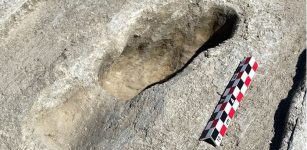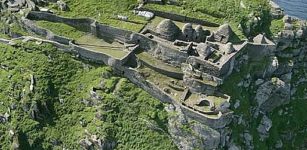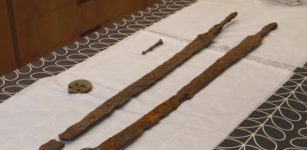Truth Behind Mysterious Ancient Metal Depositions Revealed By Scientists
Jan Bartek - AncientPages.com - In Bronze Age Europe, many bronze objects such as axes, swords and jewels were deliberately left at specific spots in the landscape. Ph.D. research by Leiden archaeologist Marieke Visser shows that these practices were expressions of people's relationship with the world around them. "It was a completely normal practice, which we shouldn't label as irrational."
Credit: Leiden University
Researchers have been trying since the 19th century to explain the motives behind selective metal depositions. But these are still shrouded in mystery. "Archaeologists have become stuck in very strict interpretation models," says Visser. "Certain criteria were drawn up and boxes ticked per find. The assumption was that there were religious and non-religious depositions. I find this approach problematic because the data often don't fit in these boxes. You can't simply project the modern idea of religion onto the Bronze Age."
Clear patterns
From a modern perspective it is illogical to throw away valuable objects, but thousands of years ago this was 'the most ordinary thing in the world," says Visser. "It seems to have been something you just did." Visser compares it with throwing coins in a fountain. "There you also deliberately throw away something of value at a certain place. You throw a coin in a fountain, not in the bin."
To gain a better understanding of these human actions, Visser focuses her research not on the motives, but rather on the actions themselves. "An incredible number of depositions have been found from throughout the Bronze Age. If you systematically research these, look at which object in which place, you discover the conventions. That shows that these objects weren't lost by accident. There are clear patterns. This was deliberate."
In the area where Visser did her research, metals did not occur naturally and were very valuable. "They had to be imported from far away. These trade networks were important. People wanted to express that their communities belonged to intraregional networks. Depositions were a way for people to relate to the world around them and their place within it."
Visser gives the example of a find in Denmark where one depot contained objects from Denmark, Central Europe and Great Britain. "It was actually a map of the networks and contacts people had at the time that is represented in that depot."
National borders
Visser studied an area (Denmark, Northwest Germany and the Northern Netherlands) that has never been studied before as a whole. "In the past studies were carried out within national borders. The finds in these three countries are very similar in nature. But they were looked at from different angles of interpretation, also from the country's history. This means similarities are lost."
See also: More Archaeology News
Visser has built up a database of finds dating from a long period and from a very wide area, which makes it easy to recognize similarities and patterns. "I hope that these data will also be used by archaeologists after me."
Written by Jan Bartek - AncientPages.com Staff Writer
More From Ancient Pages
-
 Londinium: Ancient Roman Outpost That Became Powerful City Of London
Featured Stories | Aug 16, 2018
Londinium: Ancient Roman Outpost That Became Powerful City Of London
Featured Stories | Aug 16, 2018 -
 Battle Of Arsuf – Site Where King Lionheart And The Crusaders Defeated Saladin – Found
Archaeology | Aug 1, 2020
Battle Of Arsuf – Site Where King Lionheart And The Crusaders Defeated Saladin – Found
Archaeology | Aug 1, 2020 -
 88 Ice Age Human Footprints In Utah Desert Shed New Light On Ancient Americans
Archaeology | Aug 11, 2022
88 Ice Age Human Footprints In Utah Desert Shed New Light On Ancient Americans
Archaeology | Aug 11, 2022 -
 Negev Desert’s Ancient Site Tells Story About Humans, Neanderthals Coexistence
Archaeology | Jun 19, 2021
Negev Desert’s Ancient Site Tells Story About Humans, Neanderthals Coexistence
Archaeology | Jun 19, 2021 -
 Fall Equinox Explains Unusual Alignment Of Egypt’s Great Pyramids – Engineer Says
Archaeology | Feb 26, 2018
Fall Equinox Explains Unusual Alignment Of Egypt’s Great Pyramids – Engineer Says
Archaeology | Feb 26, 2018 -
 Magnificent Skellig Michael And A 1,400-Year Old Christian Monastery
Featured Stories | Feb 8, 2016
Magnificent Skellig Michael And A 1,400-Year Old Christian Monastery
Featured Stories | Feb 8, 2016 -
 Taíno Indians Are Not Extinct – Ancient Tooth Reveals Indigenous Americans Still Have Living Descendants In The Caribbean
Archaeology | Feb 21, 2018
Taíno Indians Are Not Extinct – Ancient Tooth Reveals Indigenous Americans Still Have Living Descendants In The Caribbean
Archaeology | Feb 21, 2018 -
 Strange Case Of The ‘Impossible’ Glove Remains Unexplained – The Discovery – Part 1
Featured Stories | May 24, 2019
Strange Case Of The ‘Impossible’ Glove Remains Unexplained – The Discovery – Part 1
Featured Stories | May 24, 2019 -
 Unique Ancient Roman Cavalry Swords Found In Cotswolds, UK
Archaeology | Sep 18, 2023
Unique Ancient Roman Cavalry Swords Found In Cotswolds, UK
Archaeology | Sep 18, 2023 -
 Hundreds of Monumental ‘Kites’ Spotted in Arabian Desert
Archaeology | Sep 12, 2022
Hundreds of Monumental ‘Kites’ Spotted in Arabian Desert
Archaeology | Sep 12, 2022 -
 400-Year-Old Documents Reveal Japanese Opium Was Produced For Medical Purposes
Archaeology | Apr 5, 2018
400-Year-Old Documents Reveal Japanese Opium Was Produced For Medical Purposes
Archaeology | Apr 5, 2018 -
 Anomalies Linked To L-Shaped Structure Detected At The Western Cemetery, Giza, Egypt
Archaeology | May 11, 2024
Anomalies Linked To L-Shaped Structure Detected At The Western Cemetery, Giza, Egypt
Archaeology | May 11, 2024 -
 Unexplained Teleportation Cases Of People – Ancient Times – Part 1
Ancient Mysteries | Sep 30, 2019
Unexplained Teleportation Cases Of People – Ancient Times – Part 1
Ancient Mysteries | Sep 30, 2019 -
 ‘Sophisticated’ 4,000-Year-Old Steppe Pyramid Discovered In Kazakhstan
Archaeology | Aug 12, 2023
‘Sophisticated’ 4,000-Year-Old Steppe Pyramid Discovered In Kazakhstan
Archaeology | Aug 12, 2023 -
 Bighorn Medicine Wheel: Sacred Site And Ancient Solar Observatory
Civilizations | May 29, 2016
Bighorn Medicine Wheel: Sacred Site And Ancient Solar Observatory
Civilizations | May 29, 2016 -
 Mystery Of The Anonymous God Of Palmyra Finally Solved By Scientists
Archaeology | Jun 21, 2022
Mystery Of The Anonymous God Of Palmyra Finally Solved By Scientists
Archaeology | Jun 21, 2022 -
 DNA Reveals Unique Ancestry Of Inhabitants Of The Angolan Namib Desert
DNA | Oct 3, 2023
DNA Reveals Unique Ancestry Of Inhabitants Of The Angolan Namib Desert
DNA | Oct 3, 2023 -
 Silla: The Most Successful Of Three Korean Kingdoms
Featured Stories | Aug 22, 2023
Silla: The Most Successful Of Three Korean Kingdoms
Featured Stories | Aug 22, 2023 -
 Dark History Of Pömmelte, The German Stonehenge – What Can The Nebra Sky Disc And Archaeology Reveal?
Archaeology | Jul 3, 2018
Dark History Of Pömmelte, The German Stonehenge – What Can The Nebra Sky Disc And Archaeology Reveal?
Archaeology | Jul 3, 2018 -
 Codex Borgia: Pre-Columbian Mexican Manuscript Of Great Importance
Ancient Traditions And Customs | Sep 7, 2016
Codex Borgia: Pre-Columbian Mexican Manuscript Of Great Importance
Ancient Traditions And Customs | Sep 7, 2016

